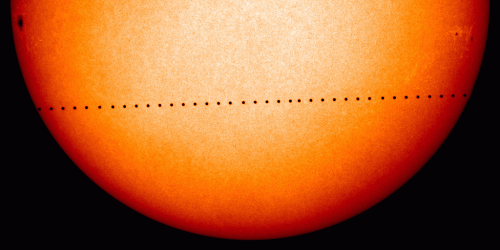Space observations of Mercury transits yield precise solar radius

(PhysOrg.com) -- A group of scientists from Hawaii, Brazil and California has measured the diameter of the Sun with unprecedented accuracy by using a spacecraft to time the transits of the planet Mercury across the face of the Sun in 2003 and 2006.
They measured the Sun’s radius as 696,342 km (432,687 miles) with an uncertainty of only 65 km (40 miles). This was achieved by using the solar telescope aboard a NASA satellite, thereby bypassing the blurring caused by Earth’s atmosphere that occurs when observations are made from the ground.
The measurements of the Sun’s size were made by University of Hawaii Institute for Astronomy scientists Drs. Marcelo Emilio (visiting from Ponta Grossa, Brazil), Jeff Kuhn and Isabelle Scholl in collaboration with Dr. Rock Bush of Stanford University. They used the Michelson Doppler Imager (MDI) aboard NASA’s Solar and Heliospheric Observatory (SOHO) to make the measurements.
“Transits of Mercury occur 12-13 times per century, so observations like this allow us to refine our understanding of the Sun’s inner structure, and the connections between the Sun’s output and Earth’s climate,” said Kuhn.
The team is preparing to observe the transit of Venus across the Sun on June 5. They expect these observations will improve the accuracy of their solar size measurement even further.
Their scientific paper, which has been accepted by the Astrophysical Journal, is available here.
Provided by University of Hawaii




















